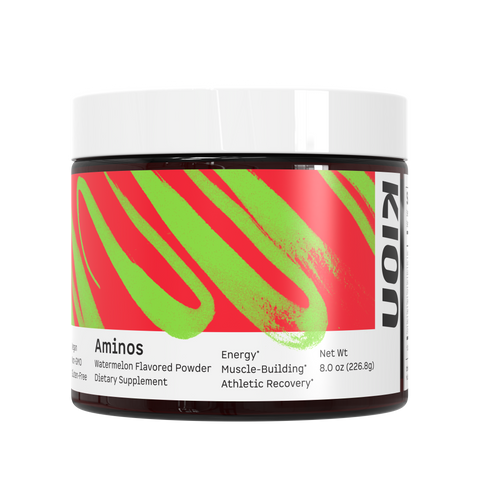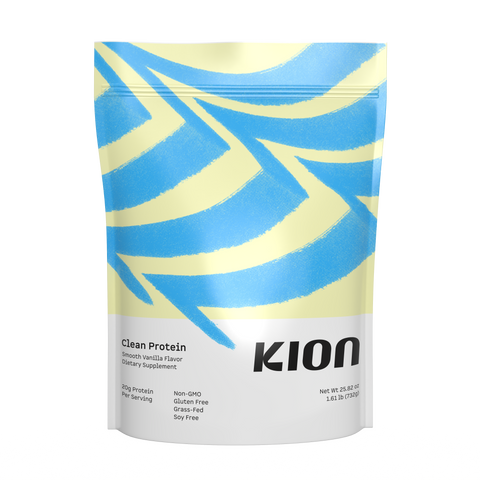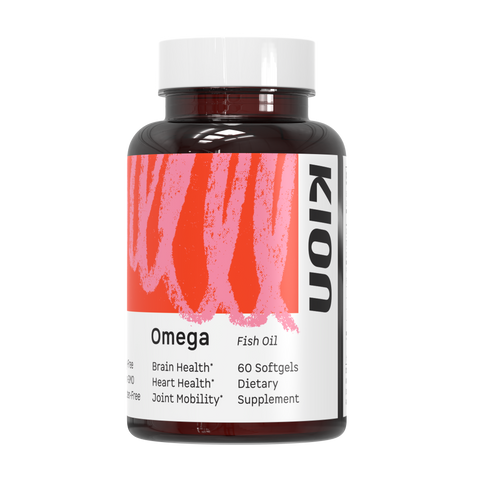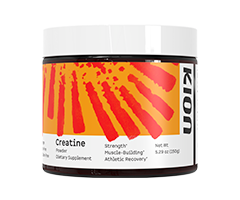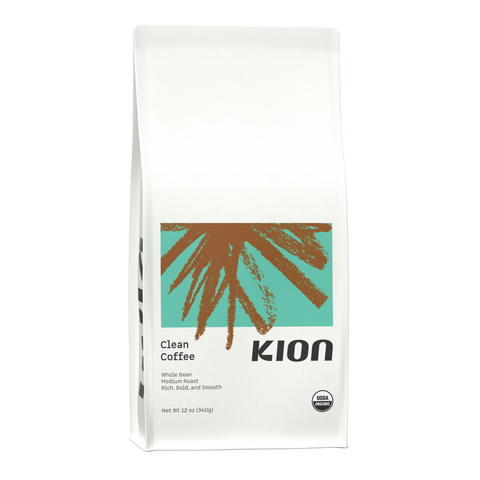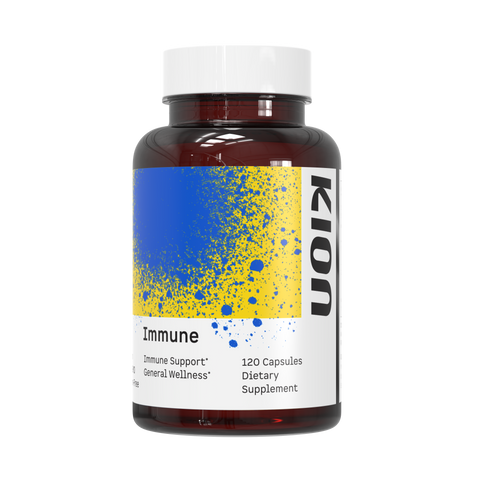At Kion, we're huge believers in bio-individuality. We'll say it over, and over, and over again. There's no one-size-fits-all anything.
This is especially true when it comes to nutrition and diet.
Convenient as it might sound to find an optimal "human species diet," the fact is that we all have individual biological responses to food.
These responses are based on variables like genetics, lifestyle, gut microbiome, environment, gender, and activity levels. This is why that strict keto diet that worked so well for your neighbor caused you to gain weight, feel lethargic, and sleep like crap.
Instead of following general diet guidelines from an Instagram post or whatever diet book is currently trending on Amazon, recent science shows it's better to personalize your diet based on your unique body.
Yes, there are certainly some general principles everyone can benefit from when it comes to a healthy diet. Focusing on whole, unprocessed, organic, local, and seasonal foods will benefit just about anyone.
But when it comes to deciding between keto or moderate carb, vegan or Paleo, OMAD or IF... How can you cut through the noise and figure out what will actually work for you?
This article will walk you through several ways to analyze your unique needs and create the perfect diet for you, so that you never have to follow another cookie-cutter meal plan again.
Why You Should Personalize Your Diet
While still a new field, personalized nutrition has become a topic of interest for researchers in the last decade.
Some of the most compelling research supporting a personalized dietary approach comes out of the Weizmann Institute of Science in Rehovot, Israel [1]. From the study abstract:
“Here, we continuously monitored week-long glucose levels in an 800-person cohort, measured responses to 46,898 meals, and found high variability in the response to identical meals, suggesting that universal dietary recommendations may have limited utility.”
Their study confirmed a high variation in glucose responses to identical meals. Foods commonly considered as "blood sugar bombs" like cookies, bananas, sushi and whole-grain bread indeed produced sharp increases in blood sugar for some participants. But interestingly, other participants showed only a moderate response or none at all.
Ummm no blood sugar spike from cookies? We want those genetics!
Their findings indicate that reliance on something such as the glycemic index, which gives fixed numbers for each food item, may be relatively useless when compared to looking at individualized blood sugar response.
Applying this information with the right approach can be extremely valuable. After showing that each of us is unique in how we absorb and metabolize nutrients, the scientists in Israel were able to use machine learning to develop an algorithm for accurately predicting personalized responses to meals. The algorithm integrates many factors like blood parameters, family history, physical activity, and gut microbiome to prescribe highly tailored dietary advice.
Another study, called the Food4Me Project, investigated 1,500 participants in seven European countries over a six month period [2]. The participants were randomly given personalized dietary advice based on their genetic data, or instead told to follow standard dietary prescriptions such as eating lots of fruits and vegetables, lean meats and whole grains.
Those in the personalized diet cohort had much better health-related outcomes than those in the one-size-fits-all diet group.
Both studies concluded that personalized diets may be a better approach than generalized dietary recommendations for overall health [1][2].
How to Find Your Perfect Diet
It's clear that a personalize approach to nutrition is a superior option. But what factors do you need to consider when choosing the best food for you?
While there is no cut-and-dry answer just yet, here are a handful of approaches you can take to craft your perfect diet.
Personalized Nutrition Approach No. 1: Genetic Testing
Before the creation of modern conveniences that allow us to eat tropical fruit in the North Pole, diet was almost strictly determined by the surrounding environment.
Northern Europeans had vastly different diets than sub-Saharan Africans or Southeast Asians. As a result, over thousands of years, natives in peoples evolved genetic adaptations to the naturally available foods in their environment.
In other words, depending on where your ancestors are from, you're potentially predisposed to do better with certain foods.
If your ancestry lies in South America, where the traditional foods are usually high in carbohydrates and starches, chances are you'll have an easier time digesting and processing high-carbohydrate foods such as grains, tubers, and fruits.
If you know for certain where most of your ancestors are from, this may be as far as you need to go. Simply eat as close as you can to the traditional diet in those regions, and you may find yourself faring much better than a Northern European eating steak tacos with extra guac every day.
However, most of us these days are ancestral mutts. This a beautiful thing, but it also makes eating for your ancestry a bit trickier.
That's where genetic testing can come in handy.
Genetic testing allows you to see what genes you possess that may affect your responses to certain foods, preferred macronutrient ratios, susceptibility to nutrient deficiencies, and likelihood for certain lifestyle diseases.
Scientists have now pinpointed genetic SNPs (single nucleotide polymorphisms) that can help you decide whether you should consume more or less folate, choline, vitamin C, fatty acids, starches, caffeine and more. The most commonly known genetic variants associated with diet include:
- MTHFR (folate, vitamin B metabolism)
- FTO (body weight and fat composition)
- TCF7L2 (blood sugar regulation)
- APOE ε4 (cholesterol)
- FADS1 (fatty acid metabolism)
- CYP1A2 (caffeine metabolism)
By doing a genetic test, you may see what SNPs you possess, and adjust your diet accordingly.
A huge caveat here: Genetic testing is in its infancy. We don't know if the variants that show up on our genetic reports are actually activated. And even worse, some genetic tests are thought to be inaccurate or even useless. So take your genetic results with a grain of salt, and continue to do your research on the best platforms available.
Personalized Nutrition Approach No. 2: Test Your Blood Glucose Response to Foods
Standardized tools like the Glycemic Index or Glycemic Load attempt to determine how high a particular food generally will spike blood sugar. However, based on what we've learned from the Weizmann Institute, blood glucose responses are highly individual.
For instance, you may eat a banana and get a smooth dose of energy and a slight rise in blood glucose, whereas your spouse may get a huge blood sugar spike and an energy crash from that same amount of banana.
Testing your blood sugar response sounds tricky, but only requires a glucometer and some test strips from your local pharmacy — a whopping $20 investment.
Instead of willy nilly taking your blood glucose after meals, it's best to take a scientific approach for the most accurate picture. Robb Wolf has a detailed description of how to do this in his 7 Day Carb Test.
For at least a week, note and observe your blood sugar response to everything you put in your body. You’ll want to start by measuring your blood glucose in the morning when your body is in a fasted state.
According to the National Institute of Health, a fasting glucose level between 72 and 108 mg/dL (4 and 6 mmol/L) is considered normal [3]. With that as a baseline, you’ll want to test immediately after each meal as well as two hours after each meal (less than 180 mg/dL is considered normal by the NIH two hours after a meal).
You’re looking to find and avoid the foods that spike your blood sugar and keep it elevated for extended periods.
Personalized Nutrition Approach No. 3: Listen To Your Body (Eat Intuitively)
All you need to do is track your hunger cues, cravings, record what you eat, how much, and how it makes you feel. You can set specific times after eating to record and decide what to assess, such as hunger, mood, energy, mental clarity, etc. Doing so will give you a greater awareness of what your body needs and how to best meet those needs. And you can get started right away, for free.
If you want to identify specific food sensitivities or triggers, then you can begin by following a brief elimination diet.
You remove all potential triggers for a minimum of 30 days to give your body a chance to reduce any chronic inflammatory response to foods so that you get a good baseline for improvements. Then, when you reintroduce different foods, your body will have a much higher sensitivity. After the 30 days, you’ll methodically reintroduce specific foods and note whether you have a poor reaction to them.
Summary
It's incredible how much you can learn about yourself with relatively simple testing and tracking! And by using your results to personalize your diet, you’ll avoid the traps of the one-size-fits-all approach and finally find the one size that fits you while meeting your nutritional needs better than any cookie cutter diet ever could.
Scientific Research
- Zeevi, David et al. “Personalized Nutrition by Prediction of Glycemic Responses.” Cell vol. 163,5 (2015): 1079-1094. doi:10.1016/j.cell.2015.11.001
- Celis-Morales, Carlos et al. “Effect of personalized nutrition on health-related behaviour change: evidence from the Food4Me European randomized controlled trial.” International journal of epidemiology vol. 46,2 (2017): 578-588. doi:10.1093/ije/dyw186
- Mathew TK, Tadi P. Blood Glucose Monitoring. [Updated 2020 Aug 14]. In: StatPearls [Internet]. Treasure Island (FL): StatPearls Publishing; 2020 Jan-. Available from: https://www.ncbi.nlm.nih.gov/books/NBK555976/
* These statements have not been evaluated by the Food and Drug Administration. This product is not intended to diagnose, treat, cure, or prevent any disease.
© 2022 Kion. All rights reserved.



